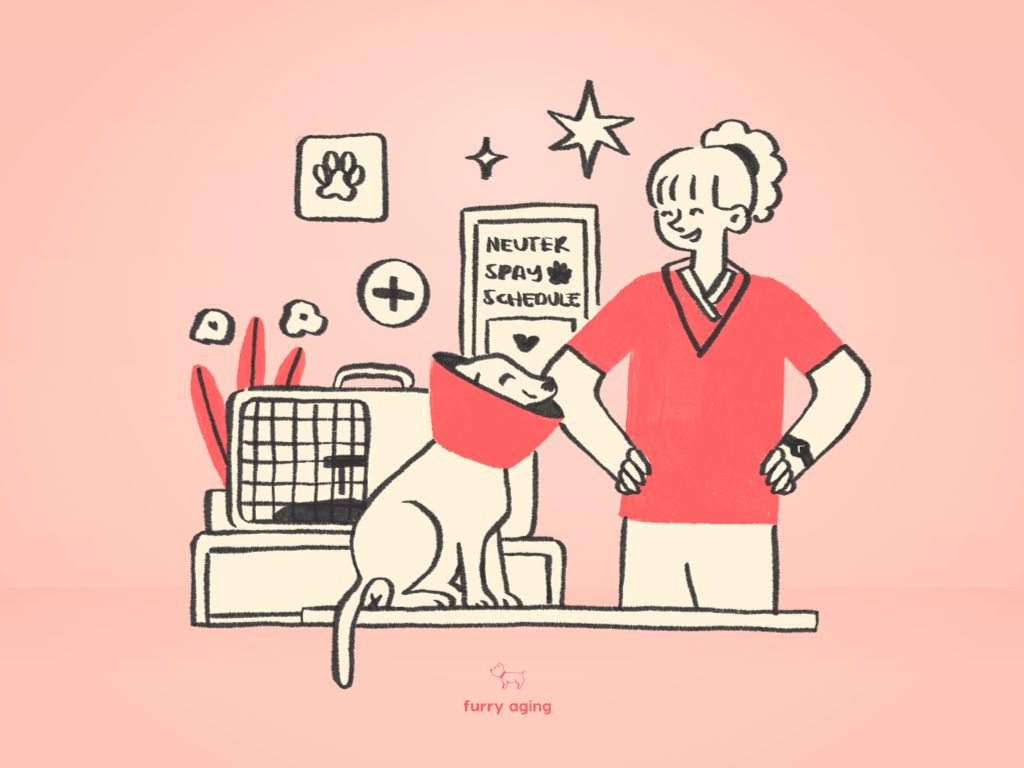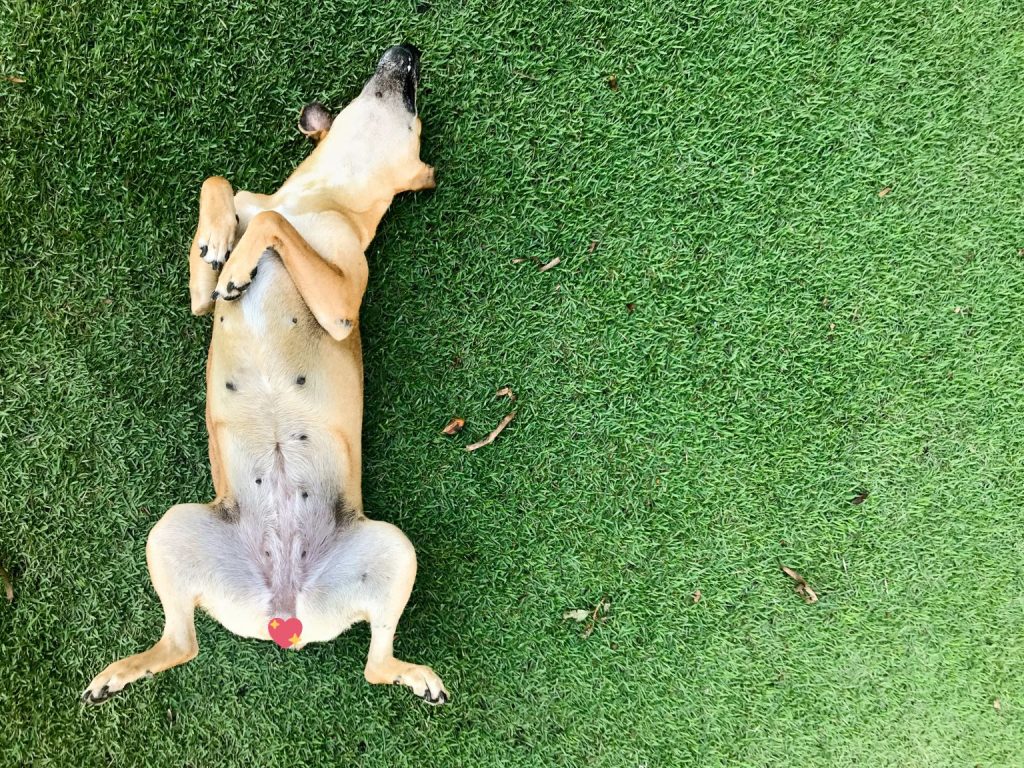
I pet sit a 15-year-old dog who is mostly healthy but recently suffered from a urinary infection that required several rounds of antibiotics. The vet ran some additional tests and discovered that he also has an enlarged prostate, a common condition in older male pets who haven’t been neutered. This condition is benign but it does bring other complications to his urinary system.
The partial solution to his problems seems to be to get him neutered, but since he is already 15 years old, it raises concerns about the safety of the surgery and whether it is worth the risk.
Spaying and neutering are standard procedures for younger pets— typically done around 6 to 12 months of age. However, when it comes to senior pets, there are additional factors to consider before deciding to perform the procedure. Let’s explore how to determine if spaying or neutering is a viable option for a senior pet, and what are the pros and cons of the procedure.
What is Spaying and Neutering?
Spaying and neutering are both surgical procedures that permanently remove the reproductive organs and prevent reproduction in pets. Spaying involves the removal of both the uterus and the ovaries in female pets and is also known as ovariohysterectomy. Neutering is the removal of the testes in male pets, also known as castration.
However, both procedures also prevent the normal production of hormones, that are needed to regulate many aspects of your pet’s health such as joint health, weight management, brain function, behavior, and others.

What is the maximum age to spay or neuter a pet?
There is no maximum age for these surgeries. However, senior pets— those who are 8 years old or older— are considered at higher risk because they are more likely to have other health issues that increase the risk associated with anesthesia and surgery.
Age is not the only factor to consider when evaluating if the pet is a candidate for the surgery. Your vet should discuss the presurgical results with you and explain the pros and cons.
The Pros of Spaying or Neutering Older Pets
1. Reduction in certain health risks
Removing the testes from male pets reduces the risk of prostatic hyperplasia, which is the enlargement of the prostate as we mentioned. This condition is noncancerous but results in complications such as difficulty urination, bloody urine, and constipation. It is common in older male pets and it happens due to high rates of testosterone. Once the testes are removed the testosterone drops and the prostate is expected to shrink.
Additionally, spaying female pets eliminates the possibility of ovarian and uterine cancer, as well as reducing the risk of mammary cancer. For male pets, neutering eliminates the risk of testicular cancer.
2. Management of behavioral problems
Neutering can help reduce or eliminate behavioral problems, such as marking behavior, aggression, hyperactivity, dominance, etc.
Going back to the example of my 15-year-old four-legged guest, he likes to mark. This is a behavior he had since puppyhood, and he wears diapers in the house to prevent accidents. The problem is that diapers could create the proper environment to develop urinary infections and as he grows older, his immune system may not respond as efficiently. So, eliminating this behavior will improve his overall wellness.
3. Prevention of unwanted litter and reproductive issues
Spaying and neutering are effective ways to reduce the overpopulation of pets, and this ultimately means fewer animals in shelters or on the streets. In senior pets, it is even more important because female dogs and cats don’t experience menopause, meaning they will continue to go into heat cycles and could get pregnant. But, pregnancy at this age can be risky and even life-threatening for them.
The Cons and Considerations
1. Potential risks associated with the procedure in older pets
The main concern about surgical procedures on senior dogs is associated with the risks of anesthesia. These risks can range from temporary issues such as vomiting or drowsiness to more serious complications like cardiac arrest or strokes.
Senior pets’ bodies may not process or eliminate the anesthesia as efficiently as their younger and healthier counterparts, which means they may take longer time to awaken. Additionally, pre-existing conditions such as heart or respiratory problems can lead to unexpected complications during surgery, putting senior dogs at an even higher risk.
To minimize the risks, vets will request a thorough pre-surgery evaluation, which includes a physical exam and blood work to determine if the pet is a candidate for this surgery. Anesthesiologists are also trained to safely administer anesthesia to any type of patient, including those who are sick or geriatric.
Nonetheless, even with pre-operative planning, there is always a risk associated with anesthesia and surgery. Some conditions can go undetected until the surgery, leading to unexpected challenges.
Other risks associated with surgery include infections and excessive bleeding.
2. Senior pet’s recovery and healing process
Generally, vets will advise to restrict the pet’s activity for the first 10 to 14 days to aid in the healing process. Senior pets may take more time to heal partly because their reproductive organs may be bigger and the surgery may require bigger incisions as well.
Post-operative Care Instructions for Senior Pets
- Closely monitor your pet for the first 24 hours and allow them to rest in a quiet, warm, and comfortable indoor place. They may show side effects of the anesthesia such as feeling nausea, wobbly, shivering, inappetence, etc. Those signs are normal and should disappear within one or two days.
- You can offer them half a meal at home, but they may not feel hungry because of the anesthesia side effects. Their appetite should return to normal within 24 hours.
- Make water available at all times.
- Restrict your pet’s activity and don’t bathe them for the next 10 to 14 days.
- Keep the incision dry, and don’t apply any ointments, sprays, or bandages. Consider using a cone or a surgical onesie to prevent your pet from licking the wound.
Pain Management
Your pet will receive pain medications before and after the surgery, these include opioids, non-steroidal anti-inflammatory, and/or local anesthetics. You may also receive an oral pain reliever (Meloxicam) to take home (only for dogs).
Note that these medications can have side effects such as diarrhea, vomiting, and reduced appetite. Follow the instructions provided by the healthcare practitioner to minimize the side effects, and contact them if the pain signs persist.
Complications
After surgery, some normal signs may occur such as a small amount of blood, redness, swelling, bruising near the incision, low energy, whining, or crying during the first night. However, pay attention to some signs that may require medical attention, such as:
- Significant swelling or redness
- Discharge or bleeding from the incision
- Vomiting days after the surgery
- Pale gums
- Loss of appetite
- Difficulty breathing
- Not waking up, or inability to stand
- Open it infected incision
Final Thoughts
Each case is different and your best source of information should be your veterinarian. That’s why it’s important to have open and honest communication with them and ask them about the procedure and the specific risks and benefits for your pet.
🐶🐱💉
Recent Posts
Is the Dogo App Worth It? Honest Review After Training My Dog
Training your dog shouldn’t feel like another chore, but it often does because, unless you’re a professional trainer, you have to research everything yourself first. And that research can take...
Amazon's Top Black Friday and Cyber Monday Deals for 2024: Dog Products Edition
The holiday shopping season has officially started and Amazon has already released some incredible deals on pet products for Black Friday and Cyber Monday 2024. Here is our curated list of the...
